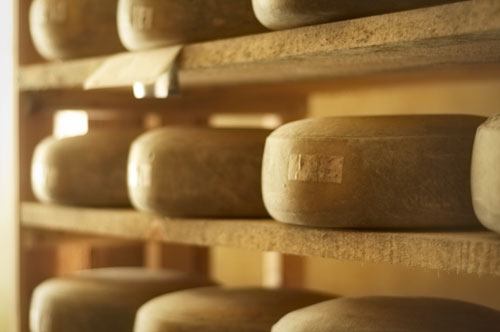A few months ago I went on a field trip with my friends Carla and Megan to Brazos Valley Cheese to visit the award-winning cheesemaker’s newly-constructed cheese cave. We drove about two hours north of Austin to Homestead Heritage, the religious homesteading community which houses the cheese cave about 30 minutes outside Waco.

A view of the fields at Homestead Heritage outside Waco, Texas. The campus houses about 100 homesteading families, and more members of the lifestyle live in nearby communities in Central Texas.
Besides Brazos Valley Cheese, the campus is home to Homestead Gristmill, Cafe Homestead, a lovely gift shop, several facilities for traditional craftsmanships, and a self-contained community of about 100 homesteading families.

Rebekah strains curds from whey at Brazos Valley Cheeses in Waco, Texas. The cheesemakers use one large vat for their operations, along with several pieces of handmade or machined specialty equipment.
Carla’s recap of the cheese shop on her blog puts my account to shame. I was so distracted by the smiling faces and unfamiliar equipment in the cheese making shed that I completely forgot to take notes of the experience.
Brazos Valley Cheese manager Marc Keuhl was kind enough to be our tour guide that day. After we looked around the building where the cheeses are made, we visited the cave on the other side of the property. The outside of the cave looks pretty humble for now, but Brazos Valley has plans to build a cheese shop and visitor’s center on the land above the cave entrance.
The cave itself feels like a 6,000 cubic feet insulated basement filled with pine bookshelves. The walls of the cave are frequently hosed with water to encourage healthy mold growth, but the floors and shelves of the space are immaculate. (As you’ll see in Carla’s post, we had to wear special shoes so that we wouldn’t introduce outside dirt and pollen into the cave.)
The pine shelves in the cave can hold 3,000 ten-to-twelve pound wheels of hard cheese. Each batch of the cheese is stored in a specific area of the cave, labeled, and monitored daily to track its progress.
After visiting the cave, we walked over to Homestead Gristmill. The miller showed us the mill, which was originally built in 18th century in the Long Valley of New Jersey. That day they were grinding whole wheat flour. The Gristmill also houses a separate, smaller, mill which is used exclusively for their gluten-free products.

The mill dates to ca. 1760 in Long Valley, New Jersey. In use for almost one hundred and sixty years until it closed in 1918, Homestead Heritage found the mill in 2000, neglected and in disrepair, and brought it to Texas to be restored.
Both mills are powered by a water wheel outside the shop. The miller controls the speed of the mill by manipulating the flow of water, ensuring that the grain is ground to a silky, uniform consistency.

Fall leaves dotted the walking paths at Homestead Heritage when we visited. This water wheel powers the community's gristmill.
Next, Marc treated us to lunch at the Homestead Cafe, where his cheeses are served along with other foods grown and prepared in house. We rounded out our visit with tours of the blacksmith shop, fibers area, and pottery shop. Since I was so delinquent in my note taking that day, I am eager to go for another visit, perhaps to a cheesemaking class taught by Marc’s cousin, Rebeccah, and the other cheesemakers.





